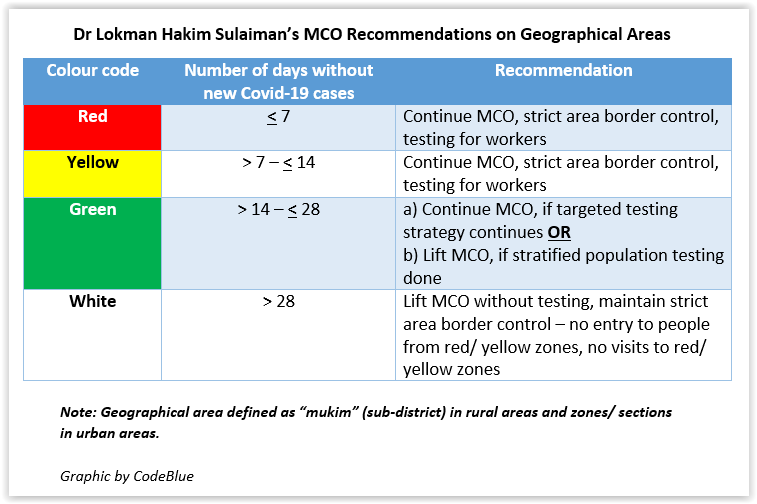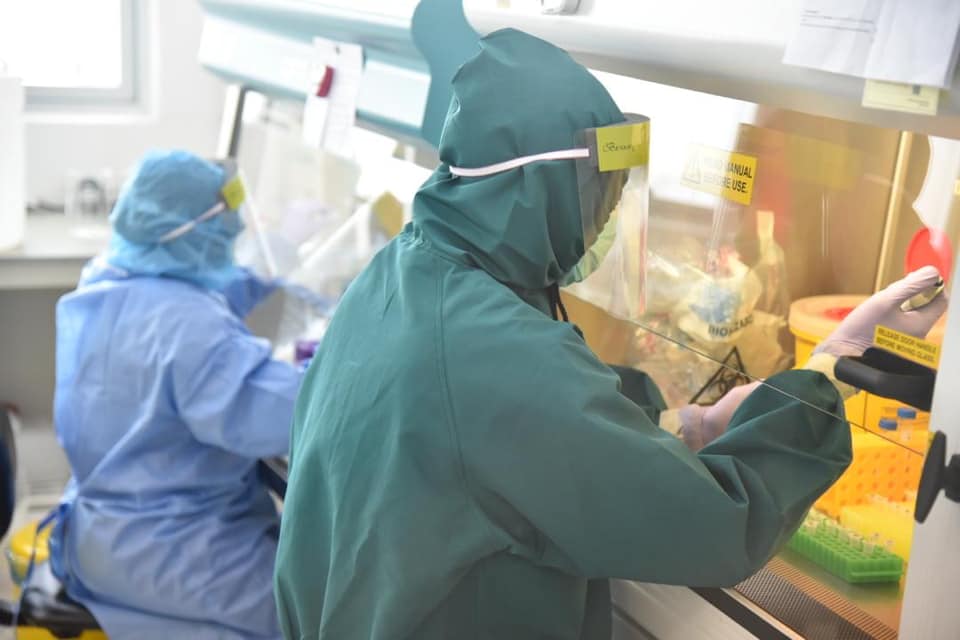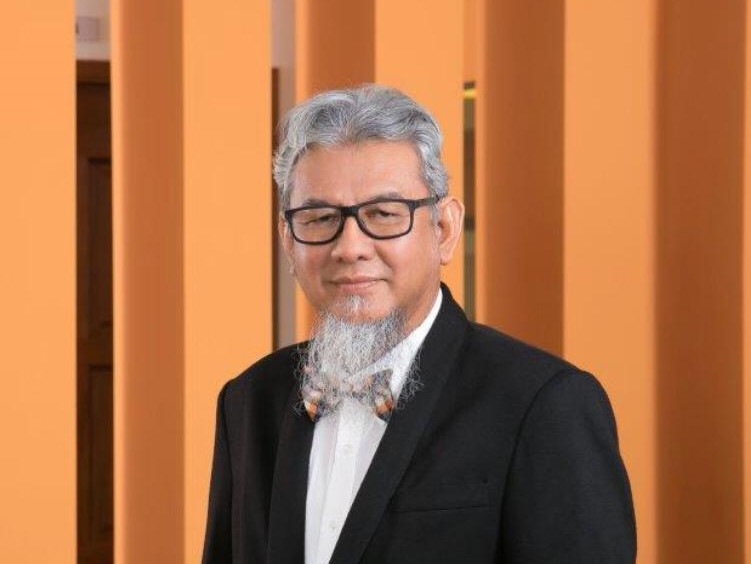KUALA LUMPUR, April 24 — A former Ministry of Health (MOH) official has suggested ending the Movement Control Order (MCO) only in areas that have not reported new Covid-19 infections for over a month.
Dr Lokman Hakim Sulaiman, former Health deputy director-general (public health), said geographical operational areas should be defined when it comes to movement control, which could be a “mukim” (sub-district) in rural areas, and smaller zones or sections in the denser urban areas.
These areas can be colour-coded into red (new cases detected within the last seven days); yellow (no new cases detected for more than a week, but detected in the last 14 days); green (no new cases detected for more than a fortnight, but detected in the last 28 days); and white (no new cases detected for more than 28 days, the length of two incubation periods for the coronavirus).
The MCO can be lifted in white areas without testing, while maintaining strict border control, such as prohibiting entry to people from red or yellow zones, and preventing residents of white areas from visiting red or yellow zones. Covid-19 testing in white areas is unnecessary, Dr Lokman said, as the assumption is that the virus transmission has been broken.
“In any scenario, you have got to make certain assumptions, i.e. the likelihood of transmission is active. When you test a person negative, you have to make the assumption that the likelihood that he is positive is very, very, very low, otherwise you will end up with testing all the time, which is ridiculous,” Dr Lokman told CodeBlue in an interview.
Lockdowns should be continued in red and yellow areas with strict border control. If the government wants to allow non-essential workers to return to work in such areas that reported new Covid-19 cases within a week or two, the International Medical University (IMU) pro-vice chancellor advised some form of testing.
“Those in green – here is the grey area. If you continue with MOH’s strategy of only targeted testing, I suggest don’t lift the MCO until it becomes white (no new cases for more than 28 days).
“If you want to lift, then you better do testing of the population, stratified according to priority area, and sample calculated based on estimated incidence,” Dr Lokman said, referring to green areas without new Covid-19 cases in more than a fortnight, but with infections reported within 28 days.

Health director-general Dr Noor Hisham Abdullah said yesterday that Perlis has reported no new cases for more than two weeks.
Prime Minister Muhyiddin Yassin announced yesterday that the MCO would be extended by another fortnight from April 28 to May 12, besides raising the possibility of a further extension that might prevent Malaysians from celebrating Hari Raya late next month in their hometowns.
Since MOH began releasing details on April 18 on daily active Covid-19 cases at the district level, the districts with zero active cases each day are predominantly located in the rural areas of Sabah and Sarawak, as well as a few districts in the northern region of the peninsula, the east coast, Perak, and Negri Sembilan.
The country’s urban centres of Kuala Lumpur, Selangor, Johor and Penang (except for southern Seberang Perai) were still reporting active cases every day. Active cases refer to Covid-19 patients who are currently in hospital after testing positive for the virus. MOH has yet to release statistics on the number of new cases each day at the district level or more granular data; only at the state level.
Treading Into Dangerous Ground Without Studies On Covid-19 Transmission In The Population

The government recently said food delivery workers and an estimated 400,000 workers from industries approved to operate during the third phase of the MCO from April 15 to 28 should be screened for Covid-19.
Muhyiddin also said yesterday that the government would consider reopening more business sectors and, if Covid-19 cases continue to decline significantly, possibly social sectors in stages.
Dr Lokman said testing was not the only factor to consider in allowing people to return to work, recommending that the elderly and those with underlying medical conditions be prohibited from entering active Covid-19 areas. Social distancing, wearing face masks and maintaining good hygiene, crowd control through shift work, and enhancing medical surveillance programmes should be implemented at workplaces.
He stressed that MOH must conduct seroprevalence studies to determine the level of exposure in the Malaysian population to Covid-19, pointing out that this could never be certain with health authorities’ targeted testing strategy of only screening high-risk groups and locations. The World Health Organization (WHO), he said, has come up with guidelines on these studies.
“I have also proposed to NIH (National Institutes of Health) a similar study not only among food [delivery] riders, but also among those who are currently in the essential services category, to provide some estimate of the level of transmission and exposure in the community.”
Dr Lokman expressed concern with sporadic cases that are not linked to any cluster. The Crisis Preparedness Response Centre (CPRC) reported on Telegram Wednesday morning that eight Covid-19 cases were detected in 1,280 samples, or 0.6 per cent, of patients with severe acute respiratory infections at selected public hospitals and clinics, also known as sentinel sites.
The former director of the Infectious Disease Control Centre at the Institute of Medical Research also pointed out that Malaysia’s rate of testing per population for the coronavirus was “relatively low” compared to other successful countries like South Korea, New Zealand, and Singapore. Malaysia ran 3,416 tests per million people as of April 19, compared to Singapore, which is among the top worldwide, with 16,203 tests per million people.
Compared to Malaysia’s some 5,600 Covid-19 cases, Singapore has reported double the number of cases at over 11,000. But Dr Lokman attributed this to Singapore’s more aggressive testing strategy.
“Because of the so-called targeted testing approach, [all] the more important for MOH to conduct seroprevalence studies to measure the level of exposure to the infection among Malaysia population. Otherwise, we are treading into a dangerous unknown situation of highly contagious infection.”
Pool Method To Expedite PCR Testing

Dr Lokman said IgM antibody, antigen detection, or PCR tests were used to detect a currently infected person, with varying costs between the tests. The gold-standard test is PCR, but it is also much more expensive and takes 24 to 48 hours to produce results in a laboratory.
“If you measure IgG [antibodies], it tells you that you have been exposed, again the assumption is the likelihood you are immune is higher and you should be given the priority to go back to work (especially those who have recovered completely – of course there are reported cases of reinfection, but compared to other naïve populations, they are better off),” said the professor of public health at IMU.
WHO said last Friday that there was currently no evidence to show that patients who have recovered from coronavirus infection and former asymptomatic carriers with antibodies will develop long-term immunity to Covid-19. But Dr Lokman said he interpreted this simply as a lack of evidence so far.
“Does it mean we stop developing a vaccine for it? No,” said Dr Lokman.
“So, under the current scenario, it is reasonable to assume that those with antibodies do have some degree of protection compared to the naïve population.”
Dr Lokman Hakim Sulaiman, former Health deputy director-general
He also suggested a pool method to improve efficiency of PCR testing, which IMU has already done. MOH has said that based on its targeted testing, about 5 per cent of those tested have positive results.
“For example, if you have 1,000 individuals to test and 5 per cent of them are positive, if you pool them into a group of 10, the first round you just test 100 pools, which most machines can do in just one reaction [for each pool]. Since 5 per cent will be positive, chances are five pools will be positive, so in the second round of PCR, you repeat the test on the individual samples (50) of the positive five pools to determine which one is positive.
“So in total, you only run 150 reactions instead of 1,000 individual (cost-saving) and complete the 1,000 samples in just one day in the laboratory with additional resources (for example, those with automatic samplers and staff on shift), but maybe three to four days if we do individual test running 24-hours (speed).”
Dr Lokman urged MOH to come up with a Covid-19 control strategy, like other infectious diseases programmes for dengue, tuberculosis, and HIV. Private clinics should be roped in as passive case detection centres to look for suspected cases, while MOH could decide what rapid test kits could be used by everyone, including general practitioner (GP) clinics, with clear case definitions, testing procedures, and interpretation.
The public health expert suggested that MOH negotiate prices for rapid diagnostic tests (RDT), saying that the key element post-MCO was early detection and isolation that can only happen with accessible tests.
“MOH has done that before for dengue Combo test when we wanted GPs to confirm suspected cases by lab testing. We brought down the price from RM70 to RM18.
“Of course, no RDT is perfect but 95 per cent sensitivity and specificity should be good enough. It was not perfect for dengue Combo too test, but we live with it. Surely we can also live with imperfect tests for Covid as long as we have good guidance on how to interpret and act on the result.”








